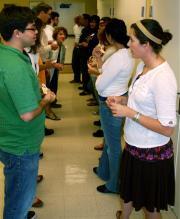Last week I shared Dan Pink’s convincing case against the use of bonuses to motivate teachers to pursue higher test scores. It is very important that we move beyond dead-end reforms such as NCLB and pay for test scores, so we can do things we know will work.
We got a clear indication this week that shows us the way. A study arrived from the American Economics Journal: Applied Economics that looks at 12 years of data from North Carolina schools, and discovered that teachers are profoundly affected by the quality of their peers. As teachers, we know how much our students can learn from one another, so it is not really surprising to learn that we teachers effect one another as well.

One of the authors, C. Kirabo Jackson, made the observation “If it’s true that teachers are learning from their peers, and the effects are not small, then we want to make sure that any incentive system we put in place is going to be fostering that and not preventing it.” He went on to say, “If you give the reward at the individual level, all of a sudden my peers are no longer my colleagues—they’re my competitors. If you give it at the school level, then you’re going to foster feelings of team membership, and that increases the incentive to work together and help each other out.”
This study found that when a strong teacher joins a staff, the performance of her colleague’s students rises significantly. Because these affects seem to persist even in cases when the strong teacher has moved on to another school, the authors believe that the reason for the improvement is that the teachers have learned to teach better. This is a working definition of teacher leadership in practice.
This resonates with me because it matches my own experience at the Oakland middle school where I taught for 18 years. Our science and math departments were struggling with turnover, so we applied and received a state grant to improve instruction (back in the days when California had a pot to put our peas in). We assigned each new teacher an experienced colleague to serve as their informal mentor, and we met several times a month to share and learn together. We conducted lesson study, developing lessons together, then observing one another teach. We looked hard at our assessment practices, and learned to do formative assessments.
There were several keys to making this work.
1. Classroom teachers were in charge. We set the direction of the project, and we chose the tools we would use to collaborate. We had a vision for what we needed and we owned the process. (This is the Autonomy Dan Pink spoke about.)
2. Our principal, Mary Hamadeh, was supportive but not prescriptive. She encouraged us to apply for the grant, but she did not attempt to micromanage it.
3. We brought in resources from partners in the community. Local experts in Lesson Study from Mills College joined us and shared protocols so we could learn from their experience. (This is the Mastery element – we were working together to build our expertise).
4. We focused on evidence of student learning. Our work with Lesson Study and formative assessment had all of us looking at how we knew what our students were actually learning. (Here we are at Purpose!)
5. We shared expertise and built collegiality. We had some outstanding experienced teachers who generously shared their best lesson and assessment ideas with their colleagues. Even beyond that, we built a community of mutual support that sustained each of us when times got tough during the year.
As a result of this work, we were able to retain all our teachers for several years, and our math scores rose for four years in a row.
Unfortunately, many of these gains were lost a few years later as the school was undermined by the loss of funds and the ravages of No Child Left Behind. Only a few of the 17 of my colleagues in the math and science departments remains there today, and most of these posts are held by interns in their first few years of teaching.
In Oakland we are working to apply these lessons to a District-wide project we call TeamScience, now in its second year. We have a team of more than twenty experienced teachers who are serving as mentors for the many novices in the District. We have partnered with the New Teacher Center to make sure our mentors are highly trained and supported, and we are also giving them opportunities to develop and share curriculum that we know will work with our students. TeamScience is working to build a district-wide culture of collegiality and mutual support in science, because we want our students to all get the best education we can give them.

We already have stories from second-year teachers that our project made a big difference for them last year. Our goal is to build on this success, and establish some stability for our science program in Oakland, so we can expand the number of expert teachers, and raise the level of learning for all our students.
What do you think? What influence have your peers had on your teaching? Do you see evidence that a strong teacher can raise the effectiveness of his or her peers? How can we improve schools based on this understanding?
Photos by Anthony Cody.